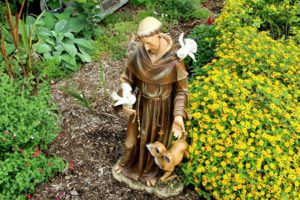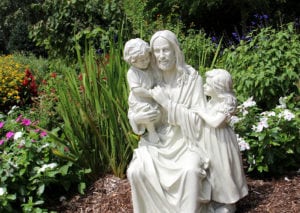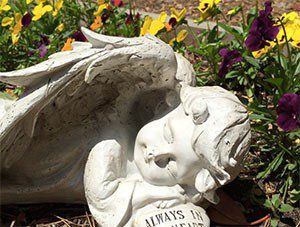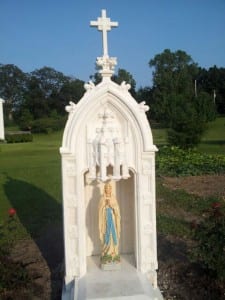 Spring is the season of rebirth and renewal and nothing brings that message home better than seeing our gardens blooming with flowers and greenery. From flowers to vegetables and herbs, there are so many different types of gardens. Have you ever considered creating a prayer garden? A prayer garden is a visual reminder of your faith and provides a serene refuge where you can spend time with God. As you tend to your gardens this spring, think about carving out a space where you can pray, meditate, or just sit quietly as you enjoy God’s natural beauty flourishing around you.
Spring is the season of rebirth and renewal and nothing brings that message home better than seeing our gardens blooming with flowers and greenery. From flowers to vegetables and herbs, there are so many different types of gardens. Have you ever considered creating a prayer garden? A prayer garden is a visual reminder of your faith and provides a serene refuge where you can spend time with God. As you tend to your gardens this spring, think about carving out a space where you can pray, meditate, or just sit quietly as you enjoy God’s natural beauty flourishing around you.
The Importance of Prayer
From an early age, we’re taught the importance of praying. As children, we proudly recited a few short prayers we were taught at home or at Catholic school. As we grew older, our prayer life evolved from memorizing easy prayers to having heartfelt conversations with God. There are so many reasons why we need to pray, but the most important reason is to open the doors to a relationship with God. Just as it’s important to communicate and spend time with loved ones, it’s just as important to foster our relationship with God.
Finding A Quiet Place to Pray
 Finding a quiet place is the best way to get the most out of your prayer time. There’s something peaceful about sitting outdoors enjoying the “silence” of the birds, the breeze, and the rustling leaves. While we can pray anytime and anywhere, it’s those times we spend in quiet, away from noise and the distractions of our fast-paced lives that we can speak from our hearts and listen to what God is saying.
Finding a quiet place is the best way to get the most out of your prayer time. There’s something peaceful about sitting outdoors enjoying the “silence” of the birds, the breeze, and the rustling leaves. While we can pray anytime and anywhere, it’s those times we spend in quiet, away from noise and the distractions of our fast-paced lives that we can speak from our hearts and listen to what God is saying.
Jesus Himself would seek time alone to pray to His father: “Very early in the morning, while it was still dark, Jesus got up, left the house and went off to a solitary place, where he prayed” (Mark 1:35). His actions served as a guide for us to spend time alone with our Heavenly Father.
Creating a Catholic Garden
There are many options when it comes to creating a religious garden, and it all comes down to personal preference. Start by thinking about where you’d like to set up your garden. Choose a quiet spot that can become your sanctuary. Once you’ve established the perfect area, decide how large you want your garden to be. It can be as simple as a small corner under a tree consisting of a religious statue and a chair, or as elaborate as water features, multiple plantings, and benches for seating.
What Should I Include in My Garden?
 Once you’ve found your location, think about how you want it to look. A good starting point is to choose a religious statue and build around it. A statue serves as a focal point and as a visual reminder of your faith when you’re spending time in your garden. There are many different types of statues to choose, including patron saints, angels, the Holy Family, and Blessed Mary. You can also choose a cross or garden stones with prayers inscribed on them. Once you’ve selected your inspirational item, think about how you want to accessorize your space. Do you want a walkway, stepping stones, or lighting?
Once you’ve found your location, think about how you want it to look. A good starting point is to choose a religious statue and build around it. A statue serves as a focal point and as a visual reminder of your faith when you’re spending time in your garden. There are many different types of statues to choose, including patron saints, angels, the Holy Family, and Blessed Mary. You can also choose a cross or garden stones with prayers inscribed on them. Once you’ve selected your inspirational item, think about how you want to accessorize your space. Do you want a walkway, stepping stones, or lighting?
What is a Mary Garden?
 As the name suggests, a Mary garden is dedicated to the Blessed Virgin. It’s a beautiful way of honoring Blessed Mary’s wish for everyone to become devoted to her immaculate heart (as revealed during her appearances in Fatima in 1917). There has always been a special connection between Mary and flowers. During the Middle Ages, missionaries spoke throughout Europe about certain flowers that represent Mary and the milestone moments in her life. Mary gardens that featured these flowers became popular in Europe, and the tradition eventually made its way to America. When building your Mary garden, consider adding lots of flowers, especially the following:
As the name suggests, a Mary garden is dedicated to the Blessed Virgin. It’s a beautiful way of honoring Blessed Mary’s wish for everyone to become devoted to her immaculate heart (as revealed during her appearances in Fatima in 1917). There has always been a special connection between Mary and flowers. During the Middle Ages, missionaries spoke throughout Europe about certain flowers that represent Mary and the milestone moments in her life. Mary gardens that featured these flowers became popular in Europe, and the tradition eventually made its way to America. When building your Mary garden, consider adding lots of flowers, especially the following:
- Lily: Lilies represent purity and grace and are often depicted in pictures of Mary
- Rose: The rose symbolizes Mary as the Queen of Heaven
- Star of Bethlehem: The star-like shape of this flower is said to represent the star the wise men followed to meet the Christ Child.
- Violet: The violet is a symbol of modesty and simplicity, qualities Mary had.
- Carnation: Legend says that the carnation bloomed on the night of Jesus’ birth
- Forget-Me-Knot: These radiant blue flowers represent Mary’s eyes.

Over the years we’ve planted a variety of such gardens. In fact I showed photos of one such corner of the yard featuring Fall flowers; the Domenican sisters at our school said, “What a wonderful place to pray!”